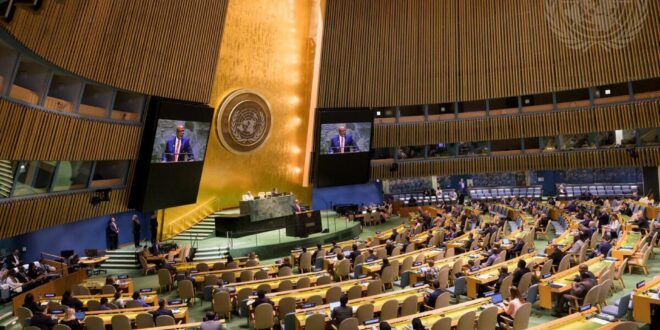It is no secret that China and Russia have been among the most vocal critics of the U.S.-led international world order, actively working to challenge its acceptance by other states. But how do these revisionist powers fare against the defender of the status quo, the United States, in the court of global opinion? Quite well, according to 30 years’ worth of U.N. data.
An analysis of voting patterns in the United Nations General Assembly, published this year by myself and Mihaela Papa of Tufts University, finds that, globally, other states are significantly more aligned with Sino-Russian policy positions than with those advocated by the United States when the two sides are at odds. From 1991 through 2020, in over 1,500 cases when the United States disagreed with China and Russia, the U.S. perspective prevailed only 14% of the time, while a majority of states aligned with the Sino-Russian positions the remaining 86% of the time. The contrast is even sharper when the analysis is limited to U.N. member states belonging to “soft-balancing groups” like the informal BRICS alliance, the Shanghai Cooperation Organization, and the G-77 bloc, a coalition of emerging economies within the U.N. system.
One caveat is that Washington seems to attach significance to relatively few of the U.N. resolutions on which it has disagreed with China and Russia, while Beijing and Moscow have engaged actively in agenda-setting at the U.N. Of the 1,513 unique General Assembly resolutions in the data set, just 211 were designated by the U.S. State Department as important to U.S. national interests — and when our analysis was limited only to those resolutions alignment with the United States was greater, at 36% among all states. China, meanwhile, sponsored (or co-sponsored) the greatest number of resolutions between 2000 and 2020 — 27% of the total versus 15% for Russia and 14% for the United States — and has done well in getting them passed, often uncontested. Moscow has also successfully mobilized other states around its interests, for example in the realm of cyber norms.
These quantitative findings suggest that the challenges Washington faces from Beijing and Moscow involve not only geopolitical posturing, but also more tacit diplomatic maneuvering aimed at winning the hearts and minds of the international community. And as China and Russia work to influence other states’ policy positions, they have relied on soft-balancing institutions like BRICS, the SCO, and the G-77. Among these groups’ member-states agreement with the U.S., as opposed to agreement with China and Russia, ranges between 7% and 14% — and the correspondence with Sino-Russian positions has increased over time. By keeping the frameworks of these organizations informal and by shifting their focus toward international development instead of democracy promotion or binding military alliances, Beijing and Moscow have garnered the affinity — or similarity in policy preferences — of large swaths of the international community, especially the Global South. (When the U.S. and Russia sponsored rival resolutions on internet governance in 2018 and 2020, Moscow’s supporters consistently ranked as less technologically advanced than Washington’s.) These trends reaffirm earlier research identifying the U.S. as a “lonely superpower” in the post-Cold War era and highlighting divergences between the interests of poor countries and the world’s largest economy.
The rapid rise of the BRICS alliance is especially noteworthy in illustrating the changing distribution of global affinity. The recent announcement at the bloc’s summit in Johannesburg that Argentina, Egypt, Ethiopia, Iran, Saudi Arabia, and the UAE will be joining BRICS leaves little doubt about its global appeal and the challenge it poses to the U.S.-led world order. The bloc’s core members — Brazil, Russia, India, China, and South Africa — have worked to overcome internal disagreements, such as China’s territorial disputes with both India and Russia. They have also advocated for an alternative framework of monetary management in competition with the U.S. dollar-oriented Bretton Woods system, though that effort has earned considerable skepticism.
More broadly, Beijing and Moscow have built a robust foreign policy coalition. Although the potential for future strife between them remains, especially as Beijing gains influence over Moscow, the coalition’s depth has been evident in the aftermath of Russia’s military incursion into Ukraine. Despite this blatant violation of territorial integrity and the heightened risk of nuclear escalation, the Chinese response has remained notably reserved, with Beijing refraining from overtly condemning the Kremlin’s actions. This measured “wait and observe” approach is mirrored in the policies of New Delhi, Brasilia, and Pretoria. While BRICS may be an informal alliance, its effects on the policy preferences of its members appear to be real and measurable.
 Eurasia Press & News
Eurasia Press & News




